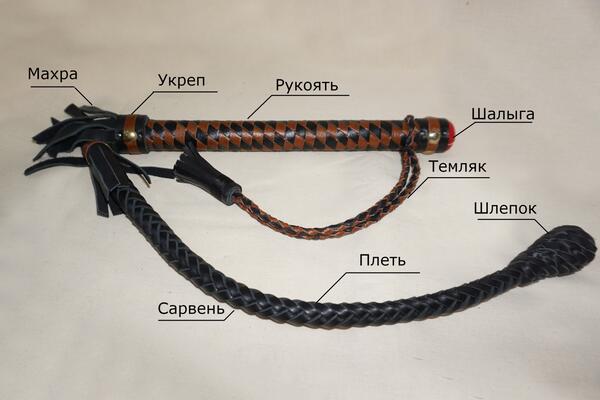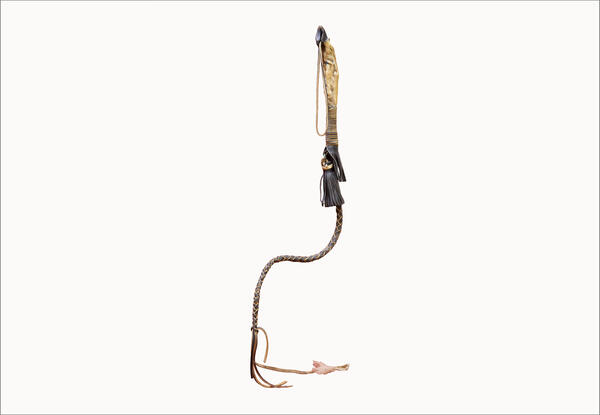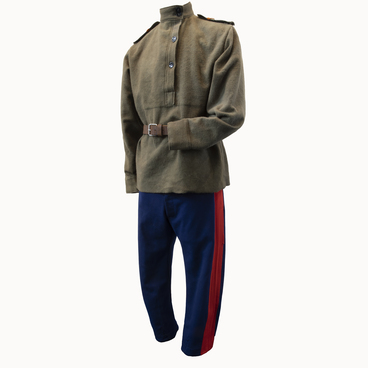This handmade nagaika is a modern replica. It was produced according to traditional techniques in 1992. It consists of a bone handle made of a split hoof. At the top, it has a loop for the hand known as a “temlyak”. The whip itself is made of thin tawed leather strips which are braided and end in a large knot.
Initially, the main purpose of a nagaika was to urge a horse. However, it gradually became a cold weapon — the Cossacks, who served the Tsar, used such whips to disperse revolutionary protests in various Russian cities. As a result, they became known as “nagaika wielders”.
The ruthless leather whip was a significant historical symbol of the Cossacks and an important attribute of the Don region’s residents. It was part of their military gear. A nagaika accompanied a Cossack throughout his life and was included in various customs: for example, a man could give a nagaika as a wedding gift to his son-in-law. Only married men could own a nagaika, and the whip had its own storage space in the master bedroom.
To demonstrate respect, a nagaika was thrown to the feet of a guest who had to return it and embrace the owner. To step over a lying whip was considered an insult. The Cossacks considered an exchange of nagaikas to be the best token of reconciliation. They also believed that a whip soaked in horse sweat could wade off evil spirits, which is why it was attached to the headboard of the bed of young women and unbaptized infants. Moreover, a Cossack was often buried together with his nagaika and his sword.
Boys were taught to use a nagaika from the age of eight years old. It was important to perform all exercises with eyes wide open to have a good view of the weapon. In combat, the whip had a secondary role and was mainly used to stun the enemy if the sword or pike had been lost. However, experienced warriors were even able to knock an enemy off their horse and deal a fatal blow.
There are several explanations of the etymology of its name. It might have originated from the Nogai people, an ethnic group that lived in the North Caucasus region. Another version is that it came from the Sanskrit word “naga” which meant “a snake” because the braiding resembled a snake scale. Finally, it could be related to the fact that the whip was tucked behind the boot shaft and was always near the leg (which is translated as “noga” in Russian).
The types and materials of nagaikas vary from region to region, but they are mostly made of bone and leather, or wood and bone. The handle is around 35-centimeter-long, while the length of the whip itself is around half a meter.
Initially, the main purpose of a nagaika was to urge a horse. However, it gradually became a cold weapon — the Cossacks, who served the Tsar, used such whips to disperse revolutionary protests in various Russian cities. As a result, they became known as “nagaika wielders”.
The ruthless leather whip was a significant historical symbol of the Cossacks and an important attribute of the Don region’s residents. It was part of their military gear. A nagaika accompanied a Cossack throughout his life and was included in various customs: for example, a man could give a nagaika as a wedding gift to his son-in-law. Only married men could own a nagaika, and the whip had its own storage space in the master bedroom.
To demonstrate respect, a nagaika was thrown to the feet of a guest who had to return it and embrace the owner. To step over a lying whip was considered an insult. The Cossacks considered an exchange of nagaikas to be the best token of reconciliation. They also believed that a whip soaked in horse sweat could wade off evil spirits, which is why it was attached to the headboard of the bed of young women and unbaptized infants. Moreover, a Cossack was often buried together with his nagaika and his sword.
Boys were taught to use a nagaika from the age of eight years old. It was important to perform all exercises with eyes wide open to have a good view of the weapon. In combat, the whip had a secondary role and was mainly used to stun the enemy if the sword or pike had been lost. However, experienced warriors were even able to knock an enemy off their horse and deal a fatal blow.
There are several explanations of the etymology of its name. It might have originated from the Nogai people, an ethnic group that lived in the North Caucasus region. Another version is that it came from the Sanskrit word “naga” which meant “a snake” because the braiding resembled a snake scale. Finally, it could be related to the fact that the whip was tucked behind the boot shaft and was always near the leg (which is translated as “noga” in Russian).
The types and materials of nagaikas vary from region to region, but they are mostly made of bone and leather, or wood and bone. The handle is around 35-centimeter-long, while the length of the whip itself is around half a meter.




